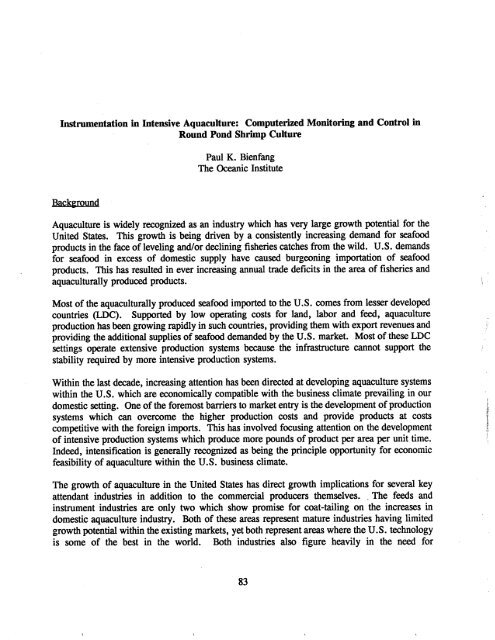WHOI-90-52
WHOI-90-52
WHOI-90-52
You also want an ePaper? Increase the reach of your titles
YUMPU automatically turns print PDFs into web optimized ePapers that Google loves.
Inrumentation in Intensive Aquaculture: Computerid Monitorig and Control in<br />
Round Pond Shrip Culture<br />
Background<br />
Paul K. Bienfang<br />
The Ocic Institute<br />
Aquaculture is widely recgnize as an industr which has very large growth potential for the<br />
United States. This growth is being driven by a consistently increasing demand for sefoo<br />
products in the face of leveling and/or declining fisheries catches from the wild. U.S. demands<br />
for seoo in excess of domestic supply have cause burgeoning importtion of sefoo<br />
products. Ths has resulted in ever increasing annual trde deficits in the area of fisheries and<br />
aquaculturay produce products. \ .<br />
Most of the aquaculturay produce sefoo imported to the U.S. comes from lesser develope<br />
countres (LDC). Support by low operating costs for land, labor and fee, aquaculture<br />
production has ben growing rapidly in such countres, providing them with export revenues and<br />
providing the additional supplies of seoo demanded by the U.S. market. Most of these LDC<br />
settings operate extensive production systems becuse the infrastrcture canot support the<br />
stabilty required by more intensive production systems.<br />
Within the last decde, increasing attntion has been directe at developing aquaculture systems<br />
within the U.S. which are ecnomicaly compatible with the business climate prevailing in our<br />
domestic settng. One of the foremost barers to market entr is the development of production<br />
systems which ca overcome the higher production costs and provide products at costs<br />
competitive with the foreign imports. This has involved focusing attention on the development<br />
of intensive production systems which produce more pounds of product per area per unit time.<br />
Indee, intensification is generaly recognize as being the principle opportunity for economic<br />
feasibilty of aquaculture withn the U. S. business climate.<br />
The growth of aquaculture in the Unite States has direct growth implications for several key<br />
attendant industres in addition to the commercial producers themselves. . The fees and<br />
instrument industres are only two which show promise for coat-taling on the increases in<br />
domestic aquaculture industr. Both of these areas represent mature industries having limited<br />
growth potential within the existing markets, yet both represent areas where the U.S. tehnology<br />
is some of the best in the world. Both industres also figure heavily in the nee for<br />
83
















